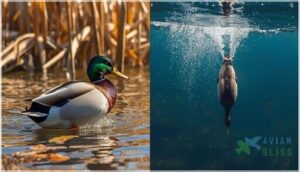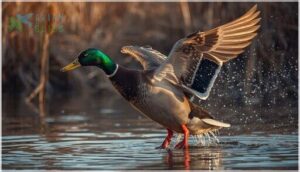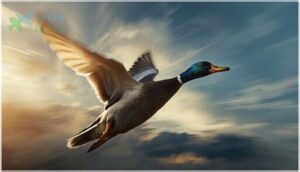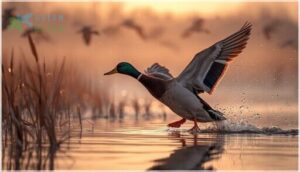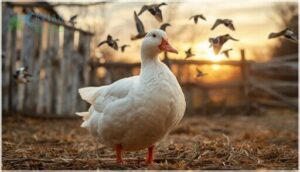This site is supported by our readers. We may earn a commission, at no cost to you, if you purchase through links.
You’ve probably watched ducks paddle serenely across a pond, then suddenly explode into the air with a thunderous flapping of wings. Yes, ducks can fly—and they’re remarkably good at it.
Most wild duck species are built for aerial prowess, with some reaching speeds of 40 to 60 miles per hour and migrating thousands of miles between continents. Their sleek bodies, powerful chest muscles, and aerodynamic feathers create a flying machine refined by millions of years of evolution.
But not all ducks share this gift. Domestic breeds, shaped by selective breeding for meat and eggs, have become too heavy and weak-winged to lift off. Understanding which ducks fly, how they do it, and why some have lost this ability reveals the fascinating intersection of biology, survival, and human influence.
Table Of Contents
Key Takeaways
- Most wild ducks are powerful fliers capable of reaching speeds between 40-60 mph and migrating thousands of miles across continents, while domestic breeds like Pekins have lost flight ability through selective breeding for meat and egg production that increased body weight and reduced wing muscle strength.
- Ducks use flight as a survival tool for three critical purposes: undertaking seasonal migrations along established flyways between breeding and wintering grounds, executing rapid escape maneuvers from predators through explosive takeoffs and zigzag patterns, and searching for scattered food sources across shifting wetland habitats.
- All ducks experience temporary flightless periods during annual molting cycles when they replace flight feathers over several weeks, leaving them grounded and vulnerable, while juveniles require 40-60 days of wing development before achieving flight capability after hatching.
- Flight serves as the invisible thread connecting duck populations across continents, enabling gene flow between distant breeding grounds and maintaining genetic diversity essential for species survival, making wetland conservation along migratory corridors critical to preventing population fragmentation.
Can Ducks Fly?
Yes, ducks can fly—and most wild species are surprisingly strong, fast fliers capable of covering hundreds of miles during migration. However, you’ll find some domestic breeds have lost this ability entirely through selective breeding for meat and egg production.
Let’s clear up the facts about duck flight and tackle a few common myths that might surprise you.
Overview of Duck Flight Abilities
Can ducks fly? Absolutely—most wild ducks possess impressive flight capabilities. They use aerodynamic feathers, structured wings, and rapid wing movement to generate lift and thrust during sustained powered flight. Their flight mechanics and aerodynamics enable them to navigate migration routes, escape predators, and explore diverse habitats.
Consider these key abilities:
- Takeoff power – Explosive wingbeats launch ducks from water or land
- Flight patterns – Coordinated wing angles and tail stabilization manage speed
- Flocking behavior – Group flights improve efficiency during long journeys
- Species variation – Migratory dabbling and diving ducks excel at flight.
Understanding the importance of methodological rigor is essential for scientific studies on animal flight.
Common Myths About Duck Flight
You’ve probably heard plenty of feathered fallacies about duck flight—let’s break down the truth. Many assume all ducks are grounded or that domestic breeds never take to the skies, but flight misconceptions run deeper than that. Understanding research methodology basics is essential for analyzing complex topics like duck flight.
| Myth | Reality |
|---|---|
| All adult ducks are flightless | Most wild ducks are capable fliers with strong avian abilities |
| Every duck migrates annually | Duck migration patterns depend on species, geography, and environmental triggers |
| Ducks only fly in straight lines | They use complex, energy-efficient routing with stopovers and detours |
Which Duck Species Can Fly?
Most wild duck species are built for flight, with powerful wings and aerodynamic bodies that let them travel hundreds of miles during migration. You’ll find that different types of ducks have evolved distinct flying styles based on their habitats and behaviors.
Let’s look at the main groups of flying ducks and what makes each one unique.
Wild Ducks and Flight Capabilities
When you watch wild duck species in action, you’re witnessing extraordinary flight capabilities built on aerodynamic feathers and powerful wingbeat frequency. Most species master sustained flight patterns essential for migration and daily foraging, traveling immense distances between breeding grounds and winter refuges.
Their coordinated flocking behavior and efficient duck flight mechanics enable them to navigate migratory routes spanning continents, connecting wetland habitats across vast geographic barriers.
Migratory Ducks
Every fall and spring, you’ll find millions of ducks defying borders, traversing four major flyways across North America—Atlantic, Mississippi, Central, and Pacific—that define their migration patterns and connect breeding grounds to southern wintering sites.
These avian migration routes showcase striking flight adaptations, guiding species through wetland ecology corridors as they follow:
- Ancient pathways refined over millennia
- Seasonal weather patterns and tailwinds
- Vital stopover wetlands for rest
- Instinctive timing synchronized with habitat changes
- Conservation-protected flight corridors
Duck migration patterns reveal nature’s blueprint for survival across continents.
Dabbling Vs. Diving Ducks
You’ll notice dabbling ducks—like mallards—tip their tails skyward, filtering seeds and vegetation from shallow wetlands, while diving ducks plunge several meters down for invertebrates and fish.
Their water depth preferences and foraging strategies shape distinct habitat selection and migration patterns, yet both groups share impressive flight capabilities, launching from ponds or open water with powerful wingbeats that carry them across continents.
Which Ducks Cannot Fly?
Not all ducks can take to the skies. Some domestic breeds have lost their flight abilities through selective breeding, while a few wild species never developed strong flight in the first place.
Let’s look at which ducks stay grounded and why they can’t fly.
Flightless Domestic Duck Breeds
You’ll find that some domestic duck breeds have traded sky-high freedom for the barnyard. American Pekins and Buff Ducks, bred for meat and eggs through selective breeding methods, carry flightlessness causes rooted in generations of human intervention.
These flightless ducks sport heavier bodies and reduced wing development, making domestic duck care simpler since they can’t escape predators or explore beyond your yard’s borders.
Wild Flightless Ducks
Island adaptation has shaped wild duck species in surprising ways. You’ll discover flightless ducks on New Zealand’s Antipodes and Auckland Islands, where evolutionary tradeoffs led to heavier bodies and smaller wings—a stark contrast to typical bird migration routes. Without predators, these waterfowl lost their need for flight.
Now, wild duck conservation efforts focus on habitat preservation, protecting these unique populations from introduced threats disrupting their ancient duck flight patterns.
Reasons for Flightlessness
You might wonder why some ducks can’t fly when their cousins soar across continents. Genetic mutations reduce wing size and flight muscle mass, while habitat changes and domestication select against flying traits.
Energy tradeoffs favor other survival strategies, and low predation pressure eliminates flight’s necessity.
Evolutionary lag explains recent flight loss in isolated populations, fundamentally altering duck flight patterns and capabilities.
How Do Ducks Fly?
When you watch a duck take off from a pond, you’re seeing one of nature’s most impressive feats of engineering in action. Their flight depends on specialized wing structures, precise aerodynamic principles, and takeoff techniques that differ dramatically between land and water.
Let’s break down exactly how these birds master the skies.
Wing Structure and Function
You’ll notice feathers play a starring role in lift generation and maneuverability, with asymmetrical wing geometry and flexible vane sections working together.
The wing structure includes lightweight bones—primaries, secondaries, and the alula—that provide rigidity without weighing ducks down.
Primary feathers generate thrust during powerful downstrokes, while the pectoralis muscles and supracoracoideus power each wingbeat, creating that aerodynamic shape that makes sustained flight possible.
Flight Mechanics and Aerodynamics
When you watch duck flight, you’re seeing a masterclass in wing aerodynamics and flight biomechanics at work. Aerodynamic forces—lift, drag, thrust, and weight—interact through precise feather dynamics to keep ducks aloft. Here’s how avian flight actually works:
- Lift generation occurs as wing mechanics create pressure differences above and below flight feathers
- Drag sources increase during takeoff, then decrease in cruising
- Power requirements demand strong pectoralis muscles for sustained wingbeats
- Air resistance is minimized by sleek body positioning
- Wing loading relationships balance body weight against available wing surface area
Bird aerodynamics reveal amazingly efficient systems evolved for long-distance travel.
Takeoff Techniques (Land Vs. Water)
You’ll notice duck flight patterns shift dramatically depending on takeoff surface. Land launch relies on wingbeat speed and leg thrust against firm ground, allowing near-vertical ascent with minimal runway length.
Water takeoff demands longer distances—ducks sprint across the surface, gradually increasing flight angles as wing mechanics generate lift against drag.
Bird aerodynamics show flying ducks adapt takeoff techniques to habitat, optimizing energy for each environment.
How Far Can Ducks Fly?
You might be surprised to learn that ducks can cover astonishing distances when they take to the skies. Some species fly hundreds or even thousands of miles without stopping, pushing the limits of endurance in ways that challenge our assumptions about these waterfowl.
Let’s explore the distances ducks usually travel, some record-breaking flights, and what factors determine how far they can go.
Typical Migration Distances
Across vast migration routes, ducks in the Anatidae family commonly traverse 1,000 to 5,000 kilometers between breeding and wintering grounds, showcasing impressive waterfowl migration patterns. You’ll find mallards covering several hundred to over 2,000 kilometers depending on their flyway, while northern shovelers frequently fly 2,000 to 4,000 kilometers seasonally.
These distance records highlight significant species variations shaped by aerodynamic factors and wildlife conservation efforts protecting critical flight routes.
Notable Long-Distance Flights
Some individual ducks set endurance records that stretch belief, flying non-stop over 3,000 kilometers in extreme migration journeys. Northern Pintails tackle transcontinental routes exceeding 5,000 kilometers in a single phase, while Eurasian Wigeons navigate thousands of kilometers between continents.
Satellite telemetry now tracks these extraordinary flight capabilities of ducks, revealing aerodynamic secrets behind animal migration’s most astonishing long-distance feats.
Factors Affecting Flight Range
You’ll notice wing span and aerodynamic shape directly control lift-to-drag ratios, dictating how efficiently ducks cruise. Energy reserves—those essential fat stores—determine endurance over marathon migrations, while wind resistance can boost or sabotage distance flown.
Flight patterns adapt to health status and stopover strategies, letting duck flight speed and distance flex with conditions. Flight capabilities of ducks hinge on these interlocking factors governing migration success.
How Fast Can Ducks Fly?
If you’ve ever watched ducks streak across the sky, you know they’re not just quick—they’re amazingly fast fliers. Most species clock in between 40 and 60 miles per hour during migration, but some record-holders leave even those speeds in the dust.
Let’s break down what you can expect from different duck species, the fastest fliers on record, and what actually makes some ducks faster than others.
Average Flight Speeds by Species
You might be surprised by the flight speed variations among duck species—each evolved unique aerodynamic factors that shape their migration patterns. When comparing species, here’s what wingbeat analysis reveals about duck flight capabilities:
- Mallards cruise around 34 mph during typical duck flight sequences
- Northern Pintails sustain roughly 37 mph on long migratory journeys
- Wood ducks maintain 25–31 mph in routine flying speed
- Teal species average 31–34 mph during bird migration
- Diving ducks like eiders fly slower at 28–31 mph compared to dabblers
Record-Holding Fastest Ducks
Speed records in the duck world reveal aerodynamic prowess you’d never expect from waterfowl. When researchers track fastest duck species using radar and GPS telemetry, the data showcases impressive flying speed capabilities across different wing morphology types.
| Duck Species | Peak Flight Speed |
|---|---|
| Red-breasted Merganser | 70 mph (escape bursts) |
| Canvasback | 70 mph (sustained) |
| Common Eider | 55 mph (level flight) |
| Mallard | 50 mph (migration) |
| Wood Duck | 31 mph (routine) |
Flight speed records depend heavily on duck aerodynamics—dabbling ducks with pointed wings achieve higher velocities than diving ducks. Avian flight dynamics research shows smaller species reach impressive speeds relative to body mass, though larger waterfowl post higher absolute numbers.
Duck migration patterns push these flight capabilities of ducks to exceptional limits during long-distance journeys.
Factors Influencing Flight Speed
When you watch ducks accelerate across the sky, wing loading plays a central role—lighter wing loading allows you to witness higher maneuverability and potentially faster speeds. Flight muscles with fast-twitch fibers power rapid takeoffs, while wind resistance and air density shift actual duck flight speeds.
Wing structure determines aerodynamic forces, where longer, narrower wingspans create efficient sustained flight behavior. Duck wingspan and aerodynamics work together, transforming physics into freedom.
Why Do Ducks Fly?
You’ve seen how fast and far ducks can fly, but what drives them to take wing in the first place? Flight isn’t just a neat trick for ducks—it’s a survival tool they depend on throughout their lives.
Let’s look at the three main reasons ducks launch themselves into the sky.
Migration and Seasonal Movement
You’ll witness one of nature’s boldest journeys when ducks undertake their seasonal movements along established flyways. Bird migration drives ducks to travel hundreds or even thousands of miles between breeding and wintering grounds, following flight corridors that connect critical stopover sites.
These migration routes align with food availability and daylight changes, requiring conservation of wetlands to guarantee successful migration journeys across continents.
Escape From Predators
Predator evasion is perhaps the most dramatic reason you’ll see ducks explode into flight. When raptors dive, dabbling ducks like northern pintails use rapid vertical takeoffs and zigzag aerial escapes, cutting down falcon strike success.
Flight reflexes trigger instantly in flocking behavior—the entire group erupts together, confusing attackers.
Diving ducks employ splash diving as an alternative escape, vanishing underwater to outlast the threat.
Searching for Food and Habitat
Flight unlocks survival for ducks by connecting them to scattered food sources and prime wetland habitats. You’ll see this active habitat selection play out as waterbird species shift locations based on resource availability:
- Dabbling and diving strategies exploit different aquatic invertebrates and plants
- Seasonal wetland ecosystems shrink or expand, forcing migration patterns
- Foraging strategies adapt to changing water levels and food abundance
- Wildlife conservation depends on protecting these interconnected corridors
Duck behavior and ecology prove flight isn’t optional—it’s the lifeline to dinner.
Can Domestic Ducks Fly?
If you’ve ever watched a domestic duck waddle around a backyard, you might wonder whether it could take off like its wild cousins. The answer isn’t straightforward, because domestication has changed these birds in some pretty significant ways.
Let’s look at what separates barnyard ducks from their airborne relatives and what it means for anyone keeping ducks at home.
Differences Between Wild and Domestic Ducks
You’ll notice wild duck species and domestic duck breeds are built differently. Wing span shows less variation in domestic ducks, while wild populations display striking genetic diversity.
Feather color in domestic breeds like the Mallard-descended varieties tends toward lighter shades from selective breeding.
Body fat patterns differ too—wild ducks store migration fuel, while domestic ones rely on your feed. Even foraging habits diverge, reshaping their entire ecology.
Breeding and Loss of Flight Ability
When you selectively breed ducks for meat and eggs, you’re actually reshaping their flight genetics. Domestic duck breeds develop reduced pectoral muscle mass and altered wing loading, often losing 40-60% of their wing power over generations.
This domestication effect isn’t always complete—some birds retain short-distance takeoff ability, though muscle atrophy from reduced activity accelerates the process considerably.
Managing Flight in Backyard Ducks
Most backyard ducks can still fly short distances if you don’t clip their wings. Can ducks fly when properly cared for? Absolutely—though domestic duck breeds often lack wild flight patterns. Here’s how you approach flock management:
- Design secure duck enclosures with elevated roosts
- Monitor wing clipping frequency carefully
- Provide balanced nutrition effects on muscle development
- Observe duck behavior and habitat preferences regularly
- Consider duck wingspan and aerodynamics when planning spaces
When Can Ducks Not Fly?
Even the strongest flyers in the duck world aren’t airborne all the time. There are predictable windows when you’ll find ducks grounded, unable to take flight no matter how much danger approaches.
Let’s look at the three main situations that temporarily clip a duck’s wings.
Molting Periods
You’ll notice your feathered friends become temporarily grounded once a year during molting cycles, when ducks replace all their flight feathers over several weeks. This flightless period happens after breeding season in wild duck species, leaving them vulnerable but essential for feather regrowth.
Molt timing varies by location and breed, with domestic ducks showing different patterns due to selective breeding. Full feather replacement restores their aerial freedom within months.
Juvenile Development and Fledging
Young ducks hit the ground running—literally swimming within hours of hatching—but you won’t see them airborne until weeks later. The fledging process spans 40 to 60 days as wing maturation and feather development catch up with rapid juvenile growth.
Dabbling ducks and diving ducks follow similar timelines, though duckling mortality during this vulnerable phase remains high across species.
Health and Environmental Factors
Disease impact and water quality directly shape your duck’s flight readiness—contaminated wetlands trigger morbidity that grounds entire populations. You’ll notice pollution effects from pesticides slowing duckling growth, while habitat loss strips away food availability needed for migration.
Environmental impact on wildlife isn’t abstract; it’s the ecological balance determining whether ducks take off or stay earthbound, making wildlife conservation and management critical for the ecological importance of migration.
How Does Flight Impact Duck Survival?
Flight isn’t just about getting from point A to point B—it’s the foundation of how ducks survive, reproduce, and adapt to a changing world. Without the ability to fly, ducks would struggle to escape predators, find food across seasons, and connect with other populations.
Let’s explore three critical ways flight shapes duck survival, from migration patterns to the habitats they depend on.
Role of Flight in Migration and Gene Flow
Think of flight as the invisible thread stitching duck populations together across continents. When migrating ducks follow their ancient migration routes, they carry genes between distant breeding grounds, mixing at crowded stopover sites where different populations mingle.
This aerial dispersal strategy maintains genetic diversity—individuals from separate origins mate during migration journeys, preventing isolation.
Without these aerodynamic adaptations enabling long-distance avian flight, duck species would fragment into disconnected gene pools, losing the variation needed for survival.
Without flight’s aerodynamic adaptations, duck species would fragment into isolated gene pools and lose the genetic variation essential for survival
Importance of Wetlands for Flight
Wetlands aren’t just pit stops—they’re lifelines that keep migratory routes alive. You’ll find these wetland habitats fueling every leg of a duck’s epic journey, supporting waterfowl conservation through habitat preservation and restoration that maintains ecological balance.
- Dense vegetation shelters resting migrants from predators during vulnerable stopovers
- Shallow waters offer aquatic invertebrates that rebuild fat reserves for continued flight
- Wetland conservation creates flight corridors linking breeding and wintering grounds
- Habitat restoration counters human disturbance, reducing migration’s energetic toll
Without wetland conservation and management, these aerial highways crumble.
Conservation Challenges and Solutions
You can’t save ducks without tackling the full storm—habitat loss, pollution, and climate chaos each chip away at their survival. Habitat restoration and wetland conservation anchor waterfowl conservation, but species protection demands climate action and ecosystem management working in tandem. Wildlife conservation thrives when conservation efforts unite communities, scientists, and policymakers to restore ecological balance through strategic habitat preservation.
| Challenge | Solution |
|---|---|
| Habitat loss reducing breeding sites | Protected area networks and habitat restoration projects |
| Water pollution from runoff | Integrated water management with agricultural practices |
| Climate-driven migration shifts | Adaptive management frameworks tracking population trends |
| Invasive species pressure | Predator control programs paired with wetland conservation |
| Fragmented habitats | Cross-border cooperation maintaining migratory corridors |
Frequently Asked Questions (FAQs)
Are ducks able to fly?
You’ll spot most wild ducks cutting through the sky like feathered arrows.
Yes, ducks fly powerfully using aerodynamic feathers and rapid wing movement, though flightless periods during molting temporarily ground even the strongest fliers.
Do ducks fly long distances?
Yes, many ducks fly long distances during migration journeys, covering hundreds to thousands of kilometers along established flyways.
Northern pintails and mallards undertake endurance flights between breeding and wintering grounds using aerodynamic feathers.
How do ducks fly?
You’ve heard ‘spread your wings‘? Ducks live it. Wing movement, driven by powerful pectoral muscle power, generates aerodynamic lift through specialized flight feathers, enabling duck flight along migration routes.
This showcases exceptional avian flight mechanics and varied flight patterns.
Do migratory ducks fly?
Migratory ducks fly hundreds to thousands of miles along established flyways during seasonal journeys. Their specialized wing morphology and aerodynamic feathers enable sustained, long-distance flight between breeding and wintering grounds.
This remarkable ability supports avian migration and wildlife conservation efforts, highlighting the importance of preserving these natural behaviors and habitats.
Do domesticated ducks fly?
Despite common assumptions, many domestic ducks can fly short distances, particularly younger, lighter breeds like mallard-derived lines.
Your backyard flock’s wing structure and feather care directly influence their flight patterns and capabilities.
Are there wild ducks that can’t fly?
Some wild duck species and populations have lost flight through evolutionary tradeoffs on isolated islands with few predators, where aerodynamic limitations became acceptable.
This has altered migration patterns and created flightless species adapted to specialized habitats.
Can ducks fly in the sky?
Yes, most duck species possess exceptional airborne abilities for skyward flight. Their aerodynamic feathers and rapid wingbeat speed enable diverse flight patterns during migration, though some domestic breeds lack these flying capabilities.
Why can’t domesticated ducks fly?
Domestic breeding for meat production increased body mass while reducing flight muscles and wing structure.
Most domesticated duck breeds lost flight genetics through selective breeding, confinement, and reduced exercise opportunities over generations.
What type of ducks can’t fly?
Most domestic breeds, like Pekin and Buff ducks, can’t fly due to heavy body weight and weak wing structure from selective breeding.
Some wild island species evolved flightlessness in predator-free habitats.
Can ducks fly from land?
Most duck species launch from solid ground just fine, powering into the air with strong wingbeats and a running start—though water takeoffs tend to be faster and smoother for these aerodynamic birds.
Conclusion
Next time someone tells you ducks are earthbound puddle-paddlers, you’ll know better. Yes, ducks can fly—wildly, powerfully, across continents and seasons. While domestic breeds waddle through backyards, their wild cousins slice through skies at breathtaking speeds, traversing thousands of miles with precision honed over millennia.
Flight isn’t just their superpower; it’s their lifeline, connecting wetlands, sustaining populations, and reminding us that nature’s engineers don’t need blueprints—just wings, instinct, and open air.
- https://www.ducks.org/conservation/waterfowl-research-science/the-big-four-diving-ducks
- https://www.vet.cornell.edu/animal-health-diagnostic-center/programs/duck-research-lab/domestic-ducks
- https://www.birdwatchingacademy.com/duck-migration/
- https://academichelpexpress.blog/2024/08/please-use-the-bulleted-points-and-the-rubric-below-to-guide-your-work-your-pa/
- https://x.com/godofprompt/status/1990526288063324577




